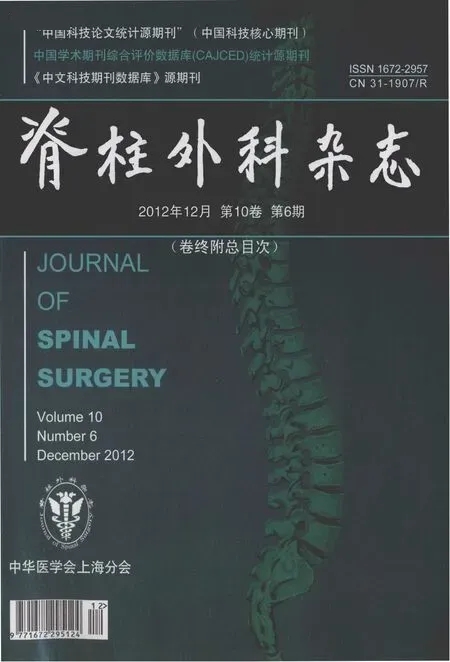脊索细胞在椎间盘退变中的研究进展
2012-04-18马俊,张颖,袁文
马 俊,张 颖,袁 文
椎间盘退行性改变是临床上引起颈腰痛、颈椎及腰椎神经根病变及颈椎脊髓病变最常见的原因。目前治疗主要以手术治疗为主,医疗支出巨大,同时也不能从根本延缓椎间盘退变的发生。如何早期抑制椎间盘退变是近年来的研究热点。脊索细胞是新发现的一类髓核组成细胞,其可以促进髓核细胞外基质成分的合成。成人髓核组织中脊索细胞的减少和消失可能与椎间盘退变的发生有关。本文将就当前脊索细胞的特征以及其在椎间盘退变方面的相关进展作简要综述。
1 脊索细胞的形态及发育特征
1.1 脊索细胞的发育史
在胚胎发育过程的原肠胚期,脊索的出现是脊椎动物体轴形成的标志。脊索起源于中胚层,充当胚胎原始的轴向骨架成分[1]。在脊索周围的中胚层组织为轴旁中胚层,轴旁中胚层有2 条,纵行排列在脊索的两侧。在发育过程中,脊索可以分泌一些信号分子诱导轴旁中胚层断裂形成块状细胞团,称为体节,每个体节都能形成生皮生肌节、生骨节,发育形成真皮、骨骼肌以及中轴骨等[2-3]。每块椎骨均来源于不同区域的生骨节细胞,两侧的生骨节细胞发育形成椎弓和椎弓根,靠中轴两生骨节相邻区域的间充质组织发育形成椎体和椎间盘纤维环[4]。人胚胎发育至5~12周时,脊索逐渐断裂形成一些细胞残留成分,后者被原始的纤维环包裹,最终形成完整的椎间盘。而胚胎脊索细胞存在于正在发育的椎间盘中,目前对于其转归尚存在争议,一般认为此类细胞会长期存在于椎间盘中并分化为髓核细胞[5-6]。
1.2 脊索细胞的自然史
一般认为,人髓核组织中脊索细胞在10岁以后就会消失。观察人髓核组织中脊索细胞存在与否与年龄的关系时发现,在新生儿髓核组织中存在很多脊索细胞,胞质中含大的空泡状结构,细胞外基质成分如蛋白多糖含量较少;而在成人髓核组织中,脊索细胞数目较少甚至消失,取而代之的是软骨样细胞,细胞与细胞外基质相对比例降低,同时伴随细胞外基质微环境的改变[7-8]。目前关于脊索细胞数目减少、消失的机制还不十分明确,可能与其向软骨样细胞分化最终达到终末分化以及细胞凋亡有关。
1.3 脊索细胞的形态特征
不成熟椎间盘髓核组织中含有脊索细胞和类软骨细胞,而后者就是通常所指的“髓核细胞”。目前脊索细胞主要是根据形态特征和相关表型来鉴定。光镜下脊索细胞常聚集成束,具有大的空泡状包涵体,常用此区别于类软骨细胞。brachyury 基因参与了胚胎发育过程中脊索的形成[9],其错误表达可导致异位脊索的形成,因此一般将髓核组织中brachyury 基因的表达作为脊索细胞存在的标志[10]。研究者发现髓核中脊索细胞和软骨样细胞两者在细胞角蛋白-8、细胞角蛋白-18、整合素亚单位(α1、α6、β1)基因表达上存在差异[11-12],在一定程度上可用于两者的鉴别。针对脊索细胞特异性的表型分子还需要进一步研究发现和证实。
2 脊索细胞对椎间盘稳态的调节
McCann 等[13]通过Noto-cre 小鼠模型证实脊索细胞和软骨样细胞都是由胚胎脊索发育而来,并认为脊索细胞是成熟髓核中软骨样细胞的前体细胞。Risbud 等[14]也证实成人椎间盘中存在脊索前体细胞,可向间充质细胞分化。Kim 等[15]将兔髓核组织中的脊索细胞分离出来体外培养时发现脊索细胞可产生蛋白多糖,表达Ⅱ型胶原和Sox-9 等软骨细胞特征表型,向包括软骨样细胞在内的几种形态不同的细胞分化,同时还具备一定的自我更新能力。脊索细胞具有干祖细胞的特性,在椎间盘细胞更新中扮演着“前体细胞”的角色[15-16]。
2.1 脊索细胞促进软骨样细胞基质合成和表型维持
Erwin 等[17]发现体外培养的脊索细胞可以分泌结缔组织生长因子(connective tissue growth factor,CTGF),后者可以促进髓核中软骨样细胞蛋白多糖等细胞外基质的合成,作者又将重组人CTGF 加入到无血清条件下培养的髓核细胞中,发现聚集蛋白聚糖表达增加,并且两者之间存在明显的剂量效应关系。赵献峰等[18]将兔髓核组织中的脊索细胞和软骨样细胞分离,按单纯软骨样细胞培养组(A组)及脊索细胞、软骨样细胞按1∶1 共培养组(B组)处理,发现B组细胞增殖能力高于A组,A组3 代以内细胞表达蛋白多糖及Ⅱ型胶原,B组细胞表型维持至5 代,脊索细胞能促进髓核软骨样细胞的增殖及表型维持。把藻酸钠微球包裹的髓核细胞和脊索细胞按1∶1 培养时,髓核细胞的活力以及细胞外基质的聚集明显增加,Ⅱ型胶原和聚集蛋白聚糖基因表达增加,而细胞增殖情况并没有明显改变[19]。Abbott 等[20]比较了2 种不同方式获得的脊索条件培养基和传统转化生长因子-β3(transforming growth factor-β3,TGF-β3)联合地塞米松诱导方式对人退变髓核中软骨样细胞的影响,发现通过海藻酸钠三维培养和组织块培养的脊索细胞释放的生长因子促进髓核细胞基质合成的作用较为明显,但细胞数目较传统TGF-β3 联合地塞米松诱导方式少,作者认为这可能与其释放的生长因子浓度不适合细胞增殖或者不释放促细胞增殖的生长因子有关。
2.2 脊索细胞抑制软骨样细胞的凋亡
脊索细胞不仅可以维持软骨样细胞的基质代谢,而且能够调控其凋亡过程。IL-1β 或IL-1β 联合Fas-配体常用于体外诱导髓核细胞凋亡和基质降解。脊索细胞释放的生长因子可以抑制caspase-9、caspase-3、caspase-7 的活性而抑制软骨样细胞的凋亡,同时上调聚集蛋白聚糖、Ⅱ型胶原、TIMP-1 基因的表达,下调基质金属蛋白酶3(matrix metalloproteinase-3,MMP-3)的表达,从而抑制细胞外基质的降解,达到维持髓核组织稳态的目的[21]。
3 脊索细胞参与椎间盘退变的可能机制
脊索细胞在不同物种中存在的时间是不一样的,有研究者发现脊索细胞存在与否与椎间盘退变是否发生密切相关。Hunter 等[22]发现非软骨营养不良品种幼年犬髓核中同时存在软骨样细胞和脊索细胞,脊索细胞聚集成束,细胞束外围有包膜包裹,而老年犬髓核中脊索细胞数目急剧下降甚至消失,软骨样细胞数目增多,而这个品种犬只有在年老后才发生椎间盘退变。在其他一些啮齿类动物的不成熟髓核组织中脊索细胞是其中最主要的细胞成份,但是在生长1年以后却很少有脊索细胞的存在[5,23],鉴于脊索细胞在椎间盘髓核基质合成和细胞活性调节方面有重要作用,脊索细胞数目的减少与椎间盘退变的发生有密切联系[22,24-25]。
脊索细胞的凋亡是脊索细胞数目减少的原因之一。Kim 等[26]发现大鼠脊索细胞组成性表达Fas、Fas 配体以及caspase-9,可能参与了脊索细胞的凋亡过程。氧化应激是导致细胞凋亡的常见原因之一。在后续的实验中,该作者通过过氧化氢作用于体外培养的脊索细胞,发现氧化应激能激活内源性凋亡通路caspase-9、外源性凋亡通路caspase-8 以及共同通路caspase-3,从而导致脊索细胞凋亡增加;抑制caspase-9 和caspase-8 的活性并不能显著抑制细胞的凋亡,而抑制caspase-3 能显著抑制氧化应激诱导的脊索细胞凋亡[27]。Suhl 等[28]比较无血清条件和正常血清条件下大鼠脊索细胞的凋亡情况时发现,当脊索细胞在无血清条件下培养时,神经生长因子(nerve growth factor,NGF)、p75 受体以及c-Jun氨基端激酶(c-Jun N-terminal kinase,JNK)信号通下游分子表达增加,与之相反,原肌球蛋白相关激酶(tropomyosin related kinase A,Trk A)受体、蛋白激酶(protein kinase B,PKB/Akt)和丝裂原活化蛋白激酶(mitogen activated protein kinase,MAPK)信号通路分子等表达下降,从而激活caspase-8、caspase-9、caspase-3,导致脊索细胞凋亡增加;NGF 通过与其TrkA 受体、p75 受体选择性结合调节脊索细胞的生存和凋亡,抑制caspase-8 和caspase-9 的活性可以显著减少细胞凋亡的发生。
除此之外,脊索细胞向软骨样细胞分化可能也参与了椎间盘退变的过程。Yang 等[29]观察针刺小鼠椎间盘退变模型不同时间段细胞组成及细胞外基质表达情况时发现,脊索细胞不断向软骨样细胞、纤维软骨样细胞分化,同时表型表达也发生改变,蛋白多糖和Ⅱ型胶原表达减少,而一些纤维软骨表型如Ⅰ型胶原、纤连蛋白等表达增加,细胞外基质成分发生改变,椎间盘高度降低。因此,在脊索细胞不断向软骨样细胞分化最终达到终末分化过程同时,细胞表型也发生相应改变,影响髓核组织的正常细胞代谢和基质合成过程,从而导致椎间盘退变的发生[10,29]。
4 脊索细胞在椎间盘修复和再生方面的应用前景
鉴于脊索细胞在维持椎间盘正常细胞代谢和基质合成方面的重要意义,因此脊索细胞在椎间盘修复和再生方面有重要的应用前景。理想的椎间盘修复方法应为运用组织工程技术,将种子细胞移植到退变椎间盘髓核组织中,保证足够有功能的细胞数目,抑制与基质降解相关酶的活性,增加细胞外基质的合成,从而达到修复椎间盘、延缓椎间盘退变的目的[30-31]。脊索细胞可能在以下几个方面用于椎间盘退变的修复:①促进髓核组织细胞外基质的合成代谢;②诱导间充质细胞向类髓核细胞定向分化;③自身作为“种子细胞”。总之,脊索细胞作为一种可能用于椎间盘退变修复的种子细胞,研究其在体内外增殖分化以及与椎间盘退变相关的机制将为椎间盘退变的治疗提供新的方向。
[1]Stemple DL.Structure and function of the notochord:an essential organ for chordate development[J].Development,2005,132(11):2503-2512.
[2]Dietrich S,Schubert FR,Gruss P.Altered Pax gene expression in murine notochord mutants:the notochord is required to initiate and maintain ventral identity in the somite[J].Mech Dev,1993,44(2-3):189-207.
[3]Pourquié O,Coltey M,Teillet MA,et al.Control of dorsoventral patterning of somitic derivatives by notochord and floor plate[J].Proc Natl Acad Sci U S A,1993,90(11):5242-5246.
[4]Christ B,Wilting J.From somites to vertebral column[J].Ann Anat,1992,174(1):23-32.
[5]Rufai A,Benjamin M,Ralphs JR.The development of fibrocartilage in the rat intervertebral disc[J].Anat Embryol(Berl),1995,192(1):53-62.
[6]Aszódi A,Chan D,Hunziker E,et al.Collagen II is essential for the removal of the notochord and the formation of intervertebral discs[J].J Cell Biol,1998,143(5):1399-1412.
[7]Trout JJ,Buckwalter JA,Moore KC,et al.Ultrastructure of the human intervertebral disc.I.Changes in notochordal cells with age[J].Tissue Cell,1982,14(2):359-369.
[8]Pazzaglia UE,Salisbury JR,Byers PD.Development and involution of the notochord in the human spine[J].J R Soc Med,1989,82(7):413-415.
[9]Takahashi H,Hotta K,Erives A,et al.Brachyury downstream notochord differentiation in the ascidian embryo[J].Genes Dev,1999,13(12):1519-1523.
[10]Risbud MV,Shapiro IM.Notochordal cells in the adult intervertebral disc:new perspective on an old question[J].Crit Rev Eukaryot Gene Expr,2011,21(1):29-41.
[11]Minogue BM,Richardson SM,Zeef LA,et al.Transcriptional profiling of bovine intervertebral disc cells:implications for identification of normal and degenerate human intervertebral disc cell phenotypes[J].Arthritis Res Ther,2010,12(1):R22.
[12]Chen J,Yan W,Setton LA.Molecular phenotypes of notochordal cells purified from immature nucleus pulposus[J].Eur Spine J,2006,15 Suppl 3:S303-311.
[13]McCann MR,Tamplin OJ,Rossant J,et al.Tracing notochordderived cells using a Noto-cre mouse:implications for intervertebral disc development[J].Dis Model Mech,2012,5(1):73-82.
[14]Risbud MV,Guttapalli A,Tsai TT,et al.Evidence for skeletalprogenitor cells in the degenerate human intervertebral disc[J].Spine(Phila Pa 1976),2007,32(23):2537-2544.
[15]Kim JH,Deasy BM,Seo HY,et al.Differentiation of intervertebral notochordal cells through live automated cell imaging system in vitro[J].Spine(Phila Pa 1976),2009,34(23):2486-2493.
[16]Smolders LA,Meij BP,Riemers FM,et al.Canonical Wnt signaling in the notochordal cell is upregulated in early intervertebral disk degeneration[J].J Orthop Res,2012,30(6):950-957.
[17]Erwin WM.The Notochord,Notochordal cell and CTGF/CCN-2:ongoing activity from development through maturation[J].J Cell Commun Signal,2008,2(3-4):59-65.
[18]赵献峰,刘浩,丰干均,等.脊索细胞促进髓核软骨样细胞增殖及表型维持[J].中国修复重建外科杂志,2008,22(8):939-943.
[19]Gantenbein-Ritter B,Chan SC.The evolutionary importance of cell ratio between notochordal and nucleus pulposus cells:an experimental 3-D co-culture study[J].Eur Spine J,2012,21 Suppl 6:S819-825.
[20]Abbott RD,Purmessur D,Monsey RD,et al.Regenerative potential of TGFβ3+Dex and notochordal cell conditioned media on degenerated human intervertebral disc cells[J].J Orthop Res,2012,30(3):482-488.
[21]Erwin WM,Islam D,Inman RD,et al.Notochordal cells protect nucleus pulposus cells from degradation and apoptosis:implications for the mechanisms of intervertebral disc degeneration[J].Arthritis Res Ther,2011,13(6):R215.
[22]Hunter CJ,Matyas JR,Duncan NA.The three-dimensional architecture of the notochordal nucleus pulposus:novel observations on cell structures in the canine intervertebral disc[J].J Anat,2003,202(Pt 3):279-291.
[23]Stevens JW,Kurriger GL,Carter AS,et al.CD44 expression in the developing and growing rat intervertebral disc[J].Dev Dyn,2000,219(3):381-390.
[24]Hunter CJ,Matyas JR,Duncan NA.Cytomorphology of notochordal and chondrocytic cells from the nucleus pulposus:a species comparison[J].J Anat,2004,205(5):357-362.
[25]Hunter CJ,Matyas JR,Duncan NA.The notochordal cell in the nucleus pulposus:a review in the context of tissue engineering[J].Tissue Eng,2003,9(4):667-677.
[26]Kim KW,Kim YS,Ha KY,et al.An autocrine or paracrine Fas-mediated counterattack:a potential mechanism for apoptosis of notochordal cells in intact rat nucleus pulposus[J].Spine(Phila Pa 1976),2005,30(11):1247-1251.
[27]Kim KW,Ha KY,Lee JS,et al.The apoptotic effects of oxidative stress and antiapoptotic effects of caspase inhibitors on rat notochordal cells[J].Spine(Phila Pa 1976),2007,32(22):2443-2448.
[28]Suhl KH,Park JB,Park EY,et al.Effect of nerve growth factor and its transforming tyrosine kinase protein and low-affinity nerve growth factor receptors on apoptosis of notochordal cells[J].Int Orthop,2012,36(8):1747-1753.
[29]Yang F,Leung VY,Luk KD,et al.Injury-induced sequential transformation of notochordal nucleus pulposus to chondrogenic and fibrocartilaginous phenotype in the mouse[J].J Pathol,2009,218(1):113-121.
[30]Drazin D,Rosner J,Avalos P,et al.Stem cell therapy for degenerative disc disease[J].Adv Orthop,2012,2012:961052.
[31]O’Halloran DM,Pandit AS.Tissue-engineering approach to regenerating the intervertebral disc[J].Tissue Eng,2007,13(8):1927-1954.
